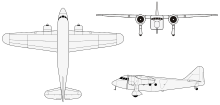Kokusai Ki-59
| Kokusai Ki-59 | |
|---|---|

|
|
| Type: | Transport plane |
| Design country: | |
| Manufacturer: | |
| First flight: |
June 1939 |
| Production time: |
1941 - |
| Number of pieces: |
59 |
The Kokusai Ki-59 ( Allied code name : Theresa ) was a twin-engine Japanese transport aircraft of the Army Air Force from World War II . The first flight as a military transport took place in June 1939.
history
Emergence
It was originally developed as a civilian cargo aircraft under the name Teradakoken TK-3 by the company Nippon Koku Kogyo Kabushiki Kaisha . It was designed as a shoulder decker in mixed construction. The rigid landing gear was clad in a streamlined manner and designed for use on unpaved airfields. Two prototypes of the TK-3 were made and flew for the first time in June 1938. Two were used as driving rating motors of the type Nakajima Kotobuki 3 640 PS. However, due to the disappointing performance, the program was discontinued.
Further development
The Japanese army was urgently looking for a transport aircraft at the time and asked Nippon to develop the model further. As a result, minor changes were made to the cockpit , landing gear and tail unit . In order to achieve a greater range , the Nakajima Kotobuki engines were exchanged for weaker Hitachi Ha-13a . The prototype of the Ki-59 took off on its maiden flight in June 1939 .
Production model
Series production began in 1941 under the name "Kokusai", as this company had now merged with Nippon. The official military designation of the Ki-59 was Heerestyp 1 Transporter . A total of 59 machines were built. Since the performance was still not satisfactory, the aircraft were used seldom and for subordinate tasks, for example as a staff aircraft.
The Ki-59 was eventually replaced by the Tachikawa Ki-54 ( Allied code name : Hickory ).
Technical specifications
| Parameter | Data |
|---|---|
| Manufacturer | Kokusai |
| Year of construction (s) | 1941 |
| crew | 2-3 |
| length | 12.53 m |
| Wingspan | 16.79 m |
| height | 3.05 m |
| Wing area | 38.4 m² |
| drive | two air-cooled 9-cylinder radial engines Hitachi Ha-13a |
| power | 331 kW (450 hp) |
| Top speed | 326 km / h |
| Empty mass | 2880 kg |
| Takeoff mass | normal 4120 kg maximum 4240 kg |
Derivative as a glider
In December 1941, a Ki-59 was converted into a cargo glider with the designation Kokusai Ku-8 ( Allied code name : Gander ). The wingspan was extended to 23.20 m and the landing gear was replaced by smaller wheels and runners . This sailor, entitled Ku-8-I , formed the basis for the Ku-8-II , the only cargo glider used by Japan during World War II.

